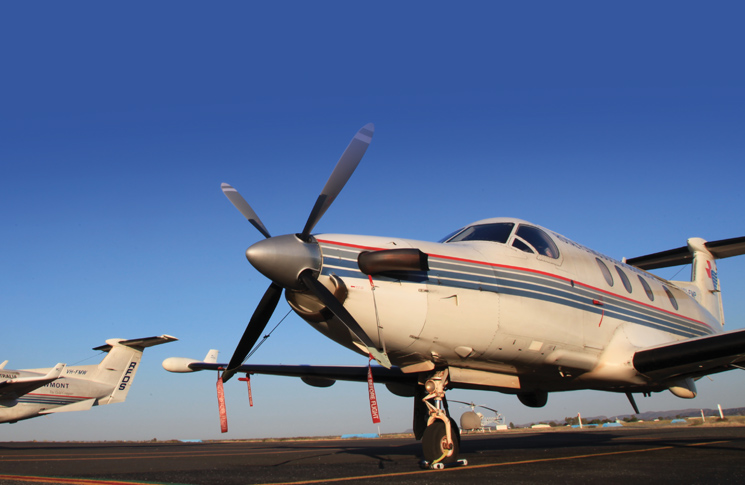By Nick Stobie
Line Pilot, Royal Flying Doctor Service Western Operations
I’ve had the pleasure of flying for the Royal Flying Doctor Service (RFDS) Western Operations for the past 18 months. In almost every way it is the challenging and fulfilling job I had expected it to be when I made the move over from the East coast: modern aircraft which serve as intensive care units in the sky and amazing people—and all for one of the most respected causes in the country.
In Western Australia the RFDS has a ‘waiting room’ spanning more than 2.5 million square kilometres, providing 24-hour aeromedical emergency evacuations to people who live, work and travel across the state.
In the last financial year, the charity’s expert medical, nursing and aviator crews travelled nearly eight million kilometres to reach 8682 patients in need of urgent medical attention.
To deliver life-saving care 24 hours a day, managing fatigue is a critical factor. Often, the only call sign you’ll hear at 3 am is another FLYDOC—a stark reminder that the service never sleeps.
A fatigue risk management system (FRMS) allows operators to design, implement and monitor their own policies for managing crews’ fatigue risks, using data and risk analysis to determine what is acceptable for their operation. As aircraft have become more efficient, airlines have been exploring FRMS as a means of safely operating longer flights that traditionally would have fallen outside the prescriptive limits of CAO 48.0/48.1.
Qantas made headlines throughout the second half of 2019 as it ran several research flights on its proposed London–Sydney and New York–Sydney routes, providing data for their fatigue systems which ultimately will need to be approved prior to commercial flights commencing.
In contrast, RFDS Western Operations faces a distinctly different set of fatigue challenges, which led to it trialling and adopting its own FRMS over the past two years.

A unique set of challenges
Even those without an aviation background will appreciate the challenges faced by single-pilot flight crews and their medical teams.
My Chief Pilot at Western Operations, Albin ‘Alby’ Unger, helps his team of line pilots manage their fatigue. He is quick to identify the obvious challenge facing RFDS across the country.
‘If you have a look at what we do, the unpredictability of the RFDS is both one of the great challenges and great rewards of the job,’ he says. ‘It’s never just A to B. Some days are pretty routine, but many aren’t. Rostering, flight and duty—we plan for that as best we can, but in an operation that doesn’t have fixed start and finish times, fatigue can really hit you quite hard.’
However, Western Operations has an extra challenge imposed by distance. ‘The size of the state is really the biggest hurdle we have,’ he says.
Crews can be tasked to conduct duty periods of more than 12 hours, sometimes involving eight hours of flight time. Stabilising patients can take as long as two hours between flights in some circumstances. Invariably these taskings happen at all times of the day, including in the dead of night. The organisation does try to avoid extended taskings when possible by providing a second crew to meet at the halfway point. However, patient condition or resource availability means this isn’t always possible.
This inherent requirement for longer taskings across the back of the clock is at odds with the industry transitioning to CAO 48.1. Therefore, Western Operations elected to implement a fatigue risk management system.
‘The late-night duty limitations under the proposed CAO 48.1 air work appendix would have severely restricted our capability and required a significant increase in crew numbers, the resources for which ultimately weren’t available,’ Alby says.
When a pilot declares fatigue, it is seen as being the responsible thing to do and welcomed as being indicative of a positive safety culture.
Managing risk
The development of the FRMS has been led by Safety, Quality and Risk Manager John Brockelsby. ‘An FRMS is how we describe the different elements that are brought together to assist us in identifying, assessing and mitigating fatigue risks,’ he says. ‘Elements include awareness and training; predictive, proactive and reactive risk assessment processes; data collection and analysis; management processes; and a fatigue risk management plan that outlines in detail how duty periods are to be configured to ensure the likelihood of fatigue is reduced to as low as reasonably practicable.’
It struck me as important to note that the system is not just a prescriptive set of limits that we’ve traditionally associated with CAO 48. Although a subset of the FRMS is a plan for how duty periods are to be configured and limited, the system is a comprehensive risk management system. Risk mitigation strategies are part of this system and Western Operations has set its own prescriptive limits. However, the real value of FRMS is the other strategies that John Brockelsby touched on.
At the core of any FRMS is data and Western Operations is no exception. Information about line operations is collated, with data points such as shift extensions, shift duration, fatigue occurrences and their causation factors, and closely monitored by Brockelsby and reviewed by a fatigue safety action group on a monthly basis.
‘We’re monitoring our line pilots and seeking their feedback, and from that data we’re constantly analysing to look back and find the causes, organisational or individual,’ he says. ‘We need to be able to change things if they’re not working, and it’s the data that gives us that ability.’
To supplement the line data, Western Operations works with Circadian Australia and their Readiband program. Readibands are wearable devices—akin to a smart watch—that measure movement, providing data to individual pilots and medical staff about their sleep/wake patterns. Although use is optional, new pilots are required to use the devices for at least three weeks, followed by a sleep consultation with Circadian.
Having been through this process and worn a Readiband for several months, I can say how valuable this was—it allowed me to make significant changes to my sleep hygiene and habits.
Also contained within the FRMS is an extensive training program for pilots, taking those who may not have a background in shift work or back-of-the-clock operations and helping them manage the associated fatigue.
Alby elaborates on this process: ‘We’re exposing new pilots to night shift during their line training with a training captain. New pilots are placed under significant pressure during these shifts and pushed to help them find their fatigue limits. We’ve got the theoretical training as well, but a lot of fatigue training is actually going out there and finding your own limits in the safety of a supervised environment.’
Coming out of the training, new pilots are instilled with confidence in the organisation’s backing of their fatigue decisions. Pilots can often be under significant inherent pressure to meet the needs of a patient and are keenly aware of the consequences that such decisions may have for that patient.
In this light, John stresses the importance of the organisation ensuring that ‘… when a pilot declares fatigue, it is seen as being the responsible thing to do and welcomed as being indicative of a positive safety culture.’
A long and unchartered road
Western Operations is the first in Australia to fully implement an FRMS under CAO 48.1. Moving from the air work provisions of the old CAO 48.0 and the standard industry exemption, the implementation process was unknown territory.
The first steps were taken in 2016, when John was first employed by Western Operations. The work began with consultations with CASA, as well as engaging external consultants with specific expertise in FRMS. CASA Safety Systems Inspector Cristian Di Camillo provided guidance throughout the project and describes it as ‘an iterative journey for both RFDS and CASA’.
Alby and John say CASA was very willing to work collaboratively with Western Operations, a sentiment that Cristian echoes. ‘Our team is proud of the relationship that we have with the aviation operators we oversee, including the RFDS, and we endeavour to maintain it with the aim of ensuring aviation safety.’
After two years of review and development, approval was received from CASA in September 2019 for the system.
Where to next?
For fatigue risk management systems generally, Cristian is confident more operators, particularly those in regular public transport with already mature safety management systems, will opt to establish an FRMS due to the flexibility it provides.
‘The general view is that only organisations that cannot otherwise operate under one of the appendices of CAO 48.1 should apply for an FRMS, considering the cost associated with it,’ he says.
Even without an FRMS, the implementation of CAO 48.1 offers operators the opportunity to implement some of the benefits when it comes to fatigue management without the need for a comprehensive system. Fatigue is a challenge facing every operator, even those without the complexity of an operation such as Western Operations.







Lack of sleep is lack of sleep, call it what you like, it’s dangerous and all the big companies put a “price tag on it.
H. Hungry
A. Angry
L. Late
T. Tired
HALT. =. STOP. surely a simple lesson for us all
John : That’s good one to remember,That sums up the whole issue,Thanks for that I will pass on to my friends and workmates.
I wonder if you remembered this one Walter
…….. 24/07/00: Queensland rescue helicopter crash kills 5 – ABC
… in central Queensland The Capricorn Helicopter Rescue Unit with 3-crew had just become airborne after pi. … the investigators arrive at the crash site, the local community is closing ranks to grieve for those who died.
Perhaps HALT would have been much more appropriate……..situational awareness?
Stay safe
John